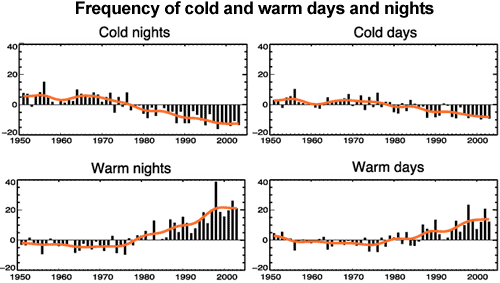Human Fingerprint on Climate Change: Nights warming faster than days
If an increased greenhouse effect was causing warming, we would expect nights to warm faster than days. This is because the greenhouse effect operates day and night. Conversely, if global warming was caused by the sun, we would expect the warming trend to be greatest in daytime temperatures. What we observe is a decrease in cold nights greater than the decrease in cold days, and an increase in warm nights greater than the increase in warm days (Alexander 2006). This is consistent with greenhouse warming.

Figure 7: Observed trends (days per decade) for 1951 to 2003 in the number of extreme cold and warm days and nights per year. Cold is defined as the bottom 10%. Warm is defined as the top 10%. Orange lines show decadal trend (IPCC AR4 FAQ 3.3 adapted from Alexander 2006).
Skeptics claim that much of the measured global warming is due to weather stations positioned near air conditioners and car parks. We know this isn’t true for several reasons.
For starters, we can compare temperatures from good weather stations to the poorly sited weather stations. Both good and bad sites show the same warming.
Another way to check the accuracy of thermometer measurements is to compare them to satellite data. Satellite measurements show the same amount of global warming. As there are no air conditioners or car parks in space to throw off the measurements, this is confirmation that the thermometers are giving us an accurate picture.
Another claim by skeptics is that it hasn’t been warming in recent years. However, there is a strong warming trend over this period. In fact, the record for the hottest 12 months in the temperature record was broken in March this year, only to be broken again in April and then again in May.
![]() This page is an extended version of A Scientific Guide to the 'Skeptics Handbook'. You can download the Scientific Guide as an A5 PDF or a printable A4 PDF that can be folded into an A5 booklet. Translations of the Scientific Guide are available here.
This page is an extended version of A Scientific Guide to the 'Skeptics Handbook'. You can download the Scientific Guide as an A5 PDF or a printable A4 PDF that can be folded into an A5 booklet. Translations of the Scientific Guide are available here.































 Arguments
Arguments



























